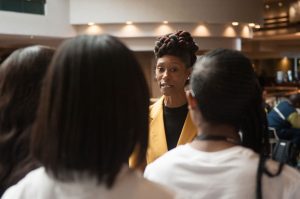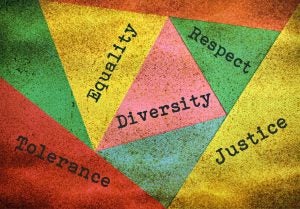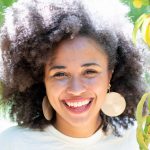Ebony Webber opened a March talk with this rhetorical question: “How do we bridge the gap where privilege exists?”
With close to 18 years of experience in nonprofit and diversity, equity, and inclusion (DEI) issues, Ebony — who is Chief Operating Officer of Minorities in Agriculture, Natural Resources and Related Sciences (MANRRS) — has sought to be a resource for students who come from minoritized backgrounds and empower them to believe in their ability. By being present in two virtual sections of Agriculture Education courses at California State University of Chico (CSUC) and speaking on privilege as it relates to allyship, she would not only be bridging the gap between DEI and agriculture education, but her message would also become a guide to future agriculture educators who would soon teach thousands of marginalized agriculture education students across California.

Ebony, who has a Certificate of Master in Diversity and Inclusion from SDG Enterprises, defined privilege as the immunity we are granted as an advantage or “going through life without worry” of racial, ethnic, spiritual, fiscal, gender, sexuality, or social barriers — among so many others. With this definition in mind, Ebony pushed the conversation forward with CSUC agriculture education class by taking us through an exercise that identified some spaces in our lives in which we had more or less privilege.
This exercise was called the “privilege walk.”
Normally in a privilege walk, students would stand in a line, side by side, and when a question was asked, they would step forward only if they could resonate with that privilege. In Ebony’s virtual version, she would share statements of privilege, and the students identified whether or not we went through life with this privilege.
In this virtual privilege walk, Ebony had us tally our privileges and shared statements like: “You are right-handed; you have never had the power cut off; your ethnic identity is American; you have 50 books in your house or more; you were never told by your parents that you’d have to work harder than everyone else to get ahead; you have never been disrespected or ignored, because of your race, ethnicity, gender, or sexual orientation.”
After 40 questions similar to the ones described, students quantified their experiences and shared the number in the chat. Many students who arrived at a lower number of privileges they resonated with were predominately ethnic or non-heterosexual identifying. While those who were closer to 40 were predominately White and heterosexual-identifying students.
“This is where white privilege resonates from. Not that White people don’t work hard, but because of the color of their skin, they historically have more privilege,” Ebony told the group.
Related: Diversity in agriculture: Will we strive for something bigger?
The idea of white privilege is a common privilege that students like me have worked around all our life. I have often taken this idea that “folks being aware of their white privilege” was the main point of this exercise.
However, Ebony encouraged us to think deeper. “This is fundamental. We all have privilege.”
Ebony reminded us all that even though racial privilege is a huge leg up to some and a barrier to others, we must also look at these results from the privilege walk and analyze other areas of privilege we have, whether we are a person of color or not. She shared that there are different privileges, such as gender, socio-economic, religious, orientation, and different abilities privilege that can all give us more privilege in certain spaces than someone else.
Ebony stressed the importance of not feeling guilty or bad for having these privileges.
“That is not the point of this exercise,” she reminded us all, scanning the faces on the Zoom call. In fact, she encouraged us to “use this conversation we just had as a compass when approaching conversations and decisions with people who don’t share in our privileges and support them.”

After the privilege walk, Ebony discussed the concept of allyship. Allyship is using our privilege to open doors of access to others, allowing them to be exposed to spaces that can aid in their success — eventually, aiding in the success of our whole society.
So, what does it look like to be an ally for our marginalized folks in agriculture?
“In order to break a system of oppression within society, it is important to intentionally set aside time to think about justice,” she said.
Whether our values align with certain aspects of how someone believes or navigates life, we must take the opportunity as consumers and agriculturalists to use our privileges to promote justice in the spaces we occupy. By doing this, we can create a culture that respects every individuals’ similarities and difference — every student, in every classroom across the country, every farmworker, in every farm across the nation, every industry leader, in every corporation or small business across the nation all have their own identities. And they are expanding.
Our goal should be to celebrate those identities and not let our privilege get in the way of bridging gaps of understanding and relationship building for an industry that truly faces some of the largest challenges. By implementing these practices of recognizing our privilege and being a good ally to others, Ebony believes strongly that we can not only improve organizational performance but truly create a better world.
Bre Holbert is a past National FFA President and studies agriculture science and education at California State-Chico. “Two ears to listen is better than one mouth to speak. Two ears allow us to affirm more people, rather than letting our mouth loose to damage people’s story by speaking on behalf of others.”



